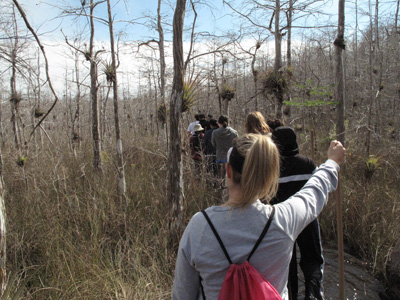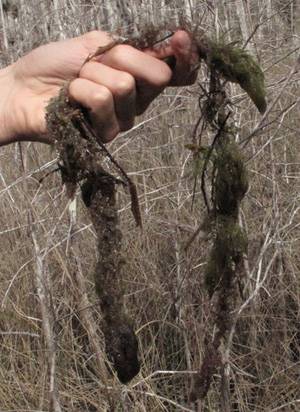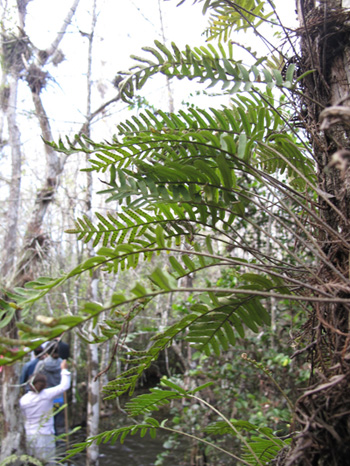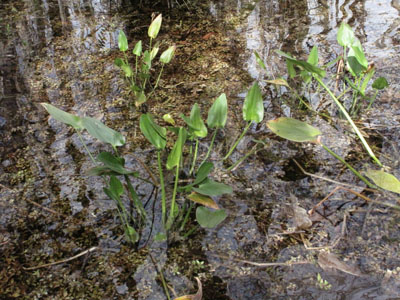
Swamp walk teaches about Big Cypress
OCHOPEE, Fla. — Trekking through waist-high waters in slosh-filled shoes and dodging tree limbs may not seem like the most romantic of activities to partake in on Valentine’s Day, but for a group of adventurous nature-loving individuals, it might just be the perfect way to spend the day.
I woke up around 9 a.m. to make my way to Big Cypress National Preserve. I was going to spend my afternoon walking through a section of the swamp in Big Cypress National Preserve that lies behind photographer Clyde Butcher’s Big Cypress Gallery, located on U.S. 41, about 35 miles west of Miami.
For those unfamiliar with Butcher’s nature photography, the photos alone are reason enough to come out to the area.
| A group of students from the University of Miami follow guide Mike Owen through the swamp (Photos by Lauren Shepherd). |  |
The walks are offered by various guides from the Gallery and are generally held on Saturdays. My particular tour was taking place on a special weekend of “Winter Swamp Walks,” which is why the walk was taking place on a Sunday.
I awoke to some of the chilliest weather I have experienced in South Florida. I checked weather.com and discovered that the high for the day was a whopping 60 degrees. Like most people, I do not like to be covered in waist-high water when the air (or water) is chilly. Still, I was excited at the prospect of spending the day in nature. Putting on a pair of old tennis shoes and long pants, I trudged onward, determined to experience all the beauty Big Cypress has to offer.
After a relatively easy registration process, our guide took us down the road from the Gallery and behind Clyde Butcher’s homey cottage to prepare for the 90-minute journey.
 |
Student Elam Portner holds up bladderwort, a plant commonly found in the Big Cypress National Preserve swamp. |
Though I was wearing tennis shoes, I ended up borrowing a pair of shoes left behind from the last group of swamp-walkers to be donated to the charity “Soles for Souls.” The shoes were still wet from the previous group, so my feet were making squishy sounds before they were even submerged into the water.
Mike Owen, our guide and fauna/flora-knowledge extraordinaire, gave us an animated presentation of what to expect. He seemed extremely excited to partake in the journey and to have the opportunity show us his world – which, in turn, made me quite excited for the experience.
First, Owen informed us that Florida was not as flat as we probably thought it to be. The swamp differs in water levels, from ankle-deep to waist-deep, and various tree roots and other forms of vegetation prevent the walk from being a mindless task.
We were each instructed to take a walking stick from a pile set out for us. This way, we could feel our way over tree roots and feel out the depth of the water in front of us to avoid any sudden drops in the water level.
Owen compared the walking stick method of traveling as a sort of underwater “Braille” system. If an area was particularly difficult to cross, we should warn the person behind us of the topography, by appropriately saying the word “topography”.
| One unique plant is the resurrection fern, which will curl up to survive droughts, and expand when water is present. |  |
Unfortunately, my excitement for the walk was temporarily postponed after my first step into the swamp. The water was freezing! Every additional step deeper into the water made me cringe. As my feet started to become numb and I was focusing on feeling out my next step, I struggled to focus on Owen’s explanation of various types of plants in the area.
Occasionally the person in front of me would stumble a bit, turn back, and warm me of “topography!” The word started to become a sort of group inside joke, as “topography” was everywhere.
We started off in waters above knee-level, but soon merged into a more shallow area and were surrounded by sawgrass. Though it was a cloudy day, the sun would occasionally peek through for glorious moments of warmth.
I learned more about nature than I have ever absorbed through a normal classroom setting. My first new piece of knowledge acquired was the difference between a marsh and a swamp. A swamp usually has woody vegetation, while a marsh is a wetland without woody vegetation – and is often more shallow.
One of the first plants Owen pointed out were resurrection ferns, which are epiphytes. An epiphyte, Owen informed us, is very much unlike a parasite. Epiphytes attach themselves to plants and get their nutrients from the bark of the other plant, but not from the plant itself.
Resurrection ferns live on the cypress trees and are a rather impressive little plant. The fern can survive through droughts by curling up and appearing completely dead and brown. As soon as it gets a little bit of water, it “resurrects” and becomes green again. Pretty cool trick. It turns out there are many epiphytes in the preserve, ranging from algae to orchids.
Another intriguing plant Owen showed us was bladderwort. Not the prettiest sounding word, but appropriate considering the look of the plant. Owen would occasionally replace a gross-sounding name of a plant with something he found less offensive. I will forever recognize one particular yellow blooming orchid as the “roller coaster orchid,” although it is technically known as the Dingy-Flowered Star Orchid.
How could something so pretty and harmless (an epiphyte, at that) be referred to as “dingy”?
Owen said he felt the orchid’s newly assigned name was appropriate because the curling blossoms resembled the fun of an amusement park ride.
 |
In more shallow waters, the bottom of the swamp is completely visible. |
Though Owen said that it appears a fire has not blazed through this particular area of swamp for at least 10 years, natural fires are common over time. Natural fires are necessary to the ecosystem of the swamp, as they bring about seed germination, and therefore promote plant diversity. I’m not usually the type of person to be excited by concepts like “seed germination” or the meaning of “epiphyte,” but being inside the swamp and realizing just how critical these concepts are to the thriving life and beauty of the preserve is a much different than reading such things from a textbook.
Of course, along with thriving plant life comes thriving animal life.
“There are snakes in the swamp, but you’re probably not going to see any,” Owen told us.
Most are harmless, though some venomous snakes do live in Big Cypress. Fortunately, I did not see any snakes on our walk.
As the journey neared to an end, I was unaware that my feet were completely numb from the cold water, as I was so entranced by my surroundings. Whenever our feet stomped on the soil beneath, the water would become hazy. Just to our left and right though, the water was crystal clear, and quite stunning. Cypress trees, orchids, and ferns surrounded me. Every now and then, I would catch a glimpse of a tiny frog or other little creature. It was quite easy to become caught up in the beauty of swamp, and I did not want the excursion to end.
As we stepped back on solid, dry ground, we were treated to a campfire to warm our numb toes, and even hot chocolate and coffee. Owen answered any questions that remained amongst the group, and then we headed back toward the Gallery to process the experience and take our time viewing Clyde Butcher’s gorgeous photography.
If You Go:
Swamp Walks: Walks are offered every Saturday at 10 a.m. and 2 p.m. from October through March. Adults are $75, and receive $25 credit at the gallery. Children under 18 are $25 and receive no gallery credit. Space is limited.
Reservations can be made online at http://evergladesswampwalks.com/reservations.htm. Private walks are available for up to 10 people and can be made by appointment. Each walk lasts approximately 1? hours.
Tips: Bring a smile, water bottle and a few snacks. Wear an old pair of tennis shoes and long pants. Be prepared for up to waist-deep water, though water levels are likely to remain knee-high. Put valuables, such as a camera or cell phone, in plastic bags.

Comments are Closed